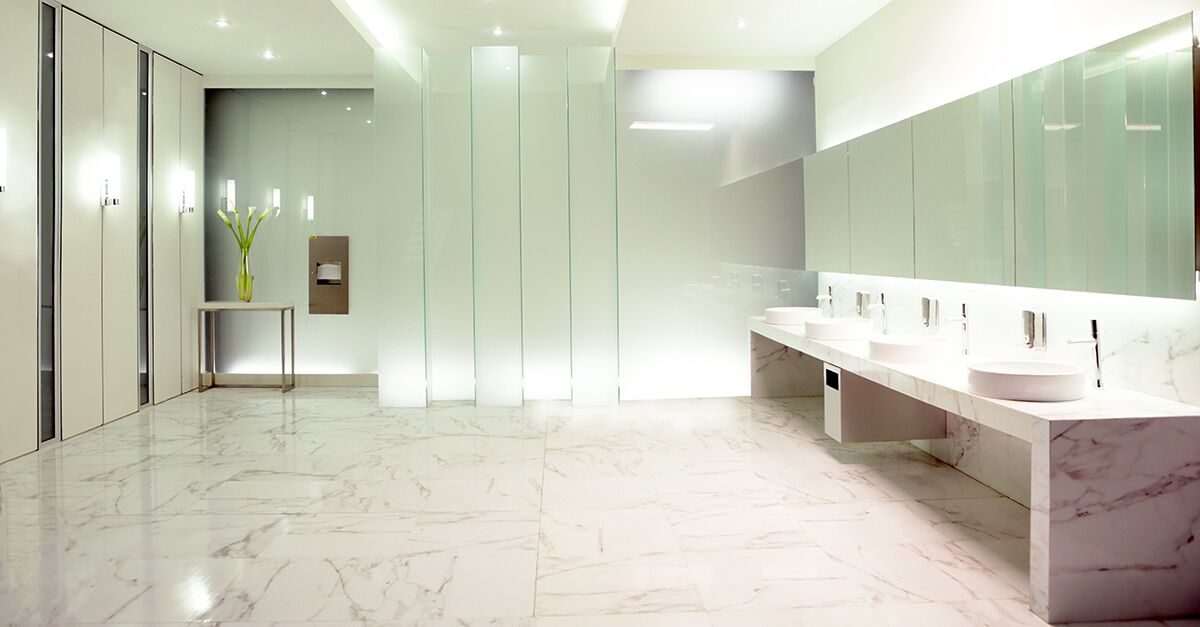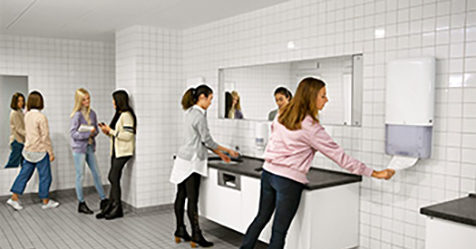The restroom has long been the bane of commercial buildings—a place dreaded by employees, avoided by visitors, and often feared by both. And with good reason. Too often, the office restroom boasts a collection of less-than-desired attributes and amenities like fluorescent lighting, leaky faucets, messy sinks, empty toilet tissue dispensers, and an overpowering and unpleasant odor. It’s no wonder restrooms consistently rank among the top areas for facility complaints.
Clearly, there’s an opportunity lurking in those dark, dingy stalls. The opportunity to create a restroom that is a differentiator, a recruitment tool, and evidence of a commitment to the environment and employee health and wellbeing. The opportunity to create the kind of restroom users desire and deserve.
Realizing that opportunity, and shifting the commercial restroom paradigm, is a challenge, but can become easier by focusing on five key considerations: improving hygiene, promoting sustainability, providing an ensured supply, creating a homelike experience, and offering a clean experience.
Consideration No. 1: Improving Hygiene
It’s pretty easy to accept that by not touching surfaces in a restroom, users greatly reduce the probability of spreading or acquiring disease-causing germs. Infection Control Today affirms this, noting 80 percent of all infectious diseases are transmitted by touch. But thanks to motion sensor light switches and sensor-operated touchless flush valves, soap dispensers, and paper towel dispensers, restroom users can keep their hands, and their germs, to themselves.
Not only do touchless dispensers improve hygiene, they also increase the perception of hygiene. According to market research, 72 percent of consumers perceive an establishment to be more hygienic if an automated touchless dispenser is present in a public restroom.
Consideration No. 2: Promoting Sustainability
Sustainability has become much more than a buzzword, and, in fact, a demonstrable commitment to sustainability affects not only how users perceive a business but also their feelings about themselves. In a 2014 study, statistics portal Statista found the majority of consumers in every age group from age 15 up strongly or completely agreed they felt guilty when doing something deemed not environmentally friendly. It follows, then, that implementing sustainable practices within the restroom enriches the experience users have. Fortunately, there are several easy ways to have a positive impact on the environment and users.
One very visible approach to sustainability is replacing white paper towels with brown. In fact, 62 percent of consumers associate brown paper towels with recycled paper. Another visible approach is to use coreless toilet tissue rolls, which eliminate both cardboard core waste as well as stub roll waste.
Additional sustainability considerations include using automatic paper towel dispensers that control dispensing, including sheet length, to discourage users from taking more towel than is needed; and automated foam soap dispensers with high-quality soap to help optimize the total amount of soap users consume when washing their hands, thereby reducing waste.
Consideration No. 3: Providing an Ensured Supply
Virtually everyone can relate to the infamous “can you spare a square” Seinfeld episode, in which Elaine finds herself in a restroom stall with no toilet tissue. It’s such a common problem, in fact, that GP PRO’s proprietary research found running out of toilet tissue ranks third among all public restroom issues. Yet there is no reason users need ever encounter this problem with today’s tissue systems that help virtually eliminate product run out. Modern systems combine dispensers that hold more and higher-capaity tissue rolls.
Having to wash hands without soap or shake off wet hands to dry them is nearly as frustrating to restroom users as running out of toilet tissue. But, again, there’s no reason for users to experience this frustration. Many of today’s soap systems offer high capacity refills to help users avoid the desperate search for a hand wipe or sanitizer. And towel dispenser systems boast dual roll auto-switch technology, which consumes the smallest roll first and allows for 100 percent usage of each roll before switching to the standby roll, ensuring a towel is always available when needed.
Another means of ensuring restroom users have a consistent supply of soap, tissue and towels is to invest in smart technology. Through a combination of wireless technologies and cutting-edge sensors, smart monitoring systems gather and disseminatetimely and customized communication between connected restroom fixtures and facility managers, empowering cleaning staff to prevent an outage before it happens.
Consideration No. 4: Creating a Homelike Experience
Despite the fact that using the restroom is a necessity, commercial restroom users don’t want a utilitarian experience. More than ever, users want their public restroom experience to be at least as pleasing as their at-home experience, complete with privacy and a positive sensory experience.
According to the American Restroom Association, white noise or background music in a restroom increases the perception of privacy. Floor-to-ceiling stall partitions and doors also give the perception of privacy and help users forget, if even momentarily, that they are not alone.
When it comes to providing a positive sensory experience, unfortunately, many commercial restrooms underperform, particularly in regards to odor. Regardless of cleaning efficacy, odors often persist and create the perception that the restroom is dirty. In fact, 74 percent of consumers assume the entire establishment is dirty if the restroom smells.
An easy solution to combat odors and ensure a clean, fresh-feeling environment is to provide a 360-degree odor control system with complementary fragrances. First, install automated motion-activated in-stall freshener dispensers to neutralize in-the-moment odors and subtly disperse an on-trend fragrance. Next, install low-splash deodorizer urinal screens to help keep urine off the restroom floor and the air smelling fresh at the same time. Finally, install a whole-room freshener dispenser to fill the entire restroom with a pleasant fragrance upon entry and exit that compliments the rest of the restroom’s odor control solutions.
Consideration No. 5: Offering a Clean Restroom
The commercial restroom often has more traffic than any other area of a building, which means it requires regular and consistent cleaning and maintenance. And a clean restroom is important not only to advance a healthier workplace but also to create a positive impression and perception. Not surprisingly, GP PRO’s proprietary research found that 85 percent of consumers say an unclean public restroom is a reflection of the overall cleanliness of an establishment.
Fortunately, offering a clean restroom is not as daunting as it may seem, particularly if a clear cleaning and maintenance regimen is consistently implemented. This regimen should include such tasks as refilling all soap, tissue, towel and odor control dispensers; wiping and disinfecting all surfaces, including fixtures, dispensers, counters, sinks, faucets, urinals, and toilets; removing dust from vents, partitions and other often overlooked surfaces; emptying all trash receptacles; removing debris from and washing the floor; and ensuring all items are in proper working order.
As noted previously, smart technology helps prevent soap, tissue and towel outages by alerting cleaning staff when supplies are low. In addition, smart technology helps ensure problems like leaky faucets and faulty flush valves are addressed quickly by alerting cleaning staff to potential issues. In short, with its consistent tracking and monitoring across the entire restroom environment, smart technology helps ensure the right staff are performing the right tasks at the right time, thereby simplifying and supporting a regular maintenance and cleaning routine.
Why It Matters
While it’s nice to make people happy, providing users with a pleasant restroom experience has far greater benefits. Countless studies have shown that cleanliness plays a key role in the experience employees, visitors and customers have in an establishment—so much so that, as a GP PRO study found, 84 percent of consumers say a poor restroom experience would make them less likely to return. Additionally, a 2015 JD Power and Associates study found that for large airports, delighted passengers spend up to 190 percent more in the airport than disappointed ones. All of which goes to show that creating a positive restroom experience propels business forward.
So change the commercial restroom paradigm. Create a positive experience for users, and create positive business results, too.




